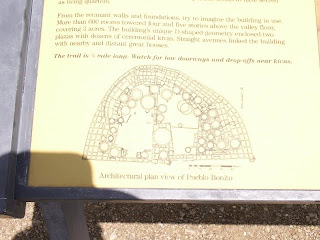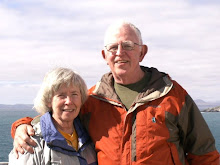About 130 miles North of Bernalillo is Chaco National Historic Site, which is reachable by traveling on good four lane highway and about twenty miles of dirt road. Just getting there is a minor adventure. I am well aware there are three hundred sixty five days in a year and that this area only gets eight inches of average rainfall a year, so why does the area get over one inch of rainfall the one day we decide to visit. Fortunately, we were in and out before the worst hit, but we left as it was moving in.
Having driven the twenty dirt road miles and having crossed the water crossing with a sign warning to not cross if there was flowing water and knowing that is your way out puts some urgency into beating the rain.
Chaco is an awesome site with some truly remarkable geology and history of Native American culture. Everywhere you turn there is something fascinating to capture your imagination.
Of course there are flowers for some travelers.
The Native Americans living at Chaco from the 800s to the 1300s were outstanding craftsmen and stone masons. Where the buildings at Coronado State Monument had been built with clay and stram balled together, the substantial buildings at Chaco were built of flat stone and in some cases with and inner and outer veneer filled with rubble. It is amazing that some of these walls are still standing 100 years latter.
One of the most fascinating things is to see petroglyphs that were created centuries ago by an Indian scratching on rocks. The soft science of archaeology has no idea about the meaning of these things, but believe they are religious symbols. They can put a rough date on the drawings by the form of the symbols.
The Chaco craftspeople used ponderosa pine quite creatively over doors, along walls and as roof beams. In the Kuau culture at Coronado SHP the women built the houses and the men moved in with them. Sounds like a good system, but at Chaco the men participated. Note the pine lentel over the door. After a thousand years, the pine has a beautiful patina.
The hollow area along this wall is where a pine support rotted out.
Pine roof support which is still in place after a thousand years.
These pictures will give you an idea of how the rocks were stacked.
Living here had some interesting hazards like this cactus pin cushion.
Of course the scenery would make up for a few cactus pricks.
This is an artist rendering of the Bonito ruins which were active from the 850s-1250s.
An architectural Drawing of Bonito Pueblo.
Exterior view of the ruins after a thousand years.
Huge square shaped boulders collapsed on Bonito on 1941 and destroyed 30 rooms.
Window in the wall. Notice the wall right behind this window. There were few openings that went straight through to other rooms. Security?
Wonder if flowers like these grew along the walls a thousand years ago?
The round rooms called Kivas were used by the men for religious ceremonies and living quarters.
The rooms were small and many were did not have ventilation or places to build fires.
Pat gives you a feeling for the size of Bonito.
Friendly little fellow whose ancestors probably lived here.
The Chaco buildings were 3-5 stories high and are mind boggling in size. I wonder why we never learned about these people in school. Visiting here brings to mind all sorts of questions and many of them are not sympathetic to Spanish or European visitors.
It takes a guide to figure out the significance of what you are looking at in these ruins.
The ancients who built this place used only rudimentary tools and had no machinery. They built this awe inspiring place the hard way. These young people are building walkway using modern tools and the omnipresent "Bobcat". My how time has changed! Seeing modern construction in a place like this forces you to realize the effort the original builders had to put forth.
Subscribe to:
Post Comments (Atom)


































No comments:
Post a Comment